Moringa has been called the “Miracle Tree” and for good reason.
It’s one of the top superfoods out there on par with avocado, salmon, quinoa, or turmeric just to name a few.
The versatility of this plant is unparalleled given how it can be used in so many different ways for survival.
If I had to choose only one kind of tree to grow in my backyard this would be it.
What is Moringa?
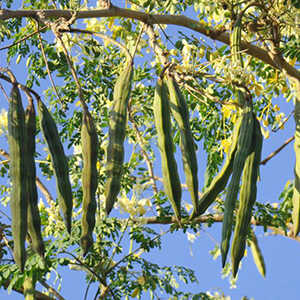
Moringa is a tree that loves arid conditions, and many countries with such climates have been utilizing it for centuries, with great success.
It has over 90 nutrients, including 8 essential amino acids that our bodies need but cannot produce on their own.
It’s like vitamins are growing on this tree – B, B1, B2, B3, D, and E are all represented in large amounts.
The Moringa has three times as much iron as spinach, four times the calcium of milk, four times the vitamin A found in carrots and is even higher in vitamin C than oranges!
It also contains large amounts of magnesium and phosphorus.
Being a powerful superfood, it has now made its way into the lives of many in the northern part of the globe as well.
The U.S.A is no exception and the Moringa can be grown outdoors in many southern and western states.
For the cooler states a greenhouse in your backyard will do just fine. Or you can grow it indoors.
An added benefit you’ll probably love about this tree is that pests do not attack it, making it easy to grow year-round with very little expense.
Water Purification
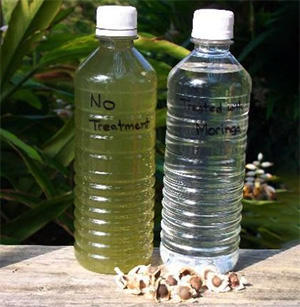 To purify your water just crush some Moringa seeds. It will remove bacteria and make it safe to drink, without any chemicals added.
To purify your water just crush some Moringa seeds. It will remove bacteria and make it safe to drink, without any chemicals added.
The seed powder can also be used as a quick and reliable method for cleaning an entire river. The powder binds with solids in the water and sinks to the bottom removing bacteria in the process.
If you don’t know how much to use, just experiment with a small vessel.
Food
First you need to realize that almost every part of this tree can be eaten, from the leaves and pods all the way down to the seeds.
Experts have concluded this tree could end world hunger, and in many dry places on Earth it’s already working hard to do just that.
The plant can also be used as animal feed. It makes chicken eggs better tasting with a rich colored yolk, helps cattle gain weight quicker and can even increase their milk production.
This is the type of feed you want for animals especially if you’re a prepper, like me, looking to get the most out of all your available resources.
The leaves, have a 28% protein content, bringing them on par with milk and cheese for example, and you can choose to eat them in a variety of ways. You can bake, juice, eat raw, or steam them.
Just know that the longer you cook them the more nutrients you’ll lose.
Moringa pods look similar to green beans and can be eaten in the same way as well.
You can choose to steam, fry, or boil them. Like many other vegetables, you want to ensure that the pod is tender so that you won’t have to eat old, fibrous pods. These are difficult to eat and don’t taste as good.
When checking the pods, snap them, and if they do so easily then they are good for eating. If not, don’t eat them as they will probably be difficult to chew.
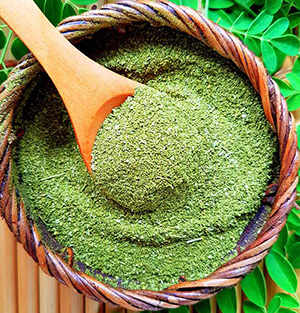
Moringa seeds can be boiled or you can sauté them. The only thing to watch out for is to not eat too much of them as they are a cleanser.
It will “clean out” your digestive system which is good but only if you don’t overdo it.
Moringa powder is a very popular form of eating this plant and it’s also the most versatile.
You can add it to juices, baked goods, and pretty much any other dish you can imagine.
Health Benefits
The Moringa will help you with everything from skin health to fighting oxidative stress in the body. Only if you look at the leaves you’ll see that they contain a very high amount of a protein, large amounts of Vitamin B6, Vitamin C, Vitamin A, iron, riboflavin, and magnesium.
Increased energy
A single serving of Moringa contains about 3 times the iron of spinach. Iron is essential to enriching the blood, carrying life, energy and oxygen into your muscles, organs and tissues.
Healthy bowel movements
Moringa oils and fiber have a detoxifying effect to help scrub your bowel of waste and toxins allowing you to fully absorb nutrients from the foods you eat. This is vital for survival especially when food becomes scarce.
Clear vision and improved eye health
High in beta carotene and vitamin A, Moringa supports healthy eyes and clear vision.
Stabilizes Blood Sugar Levels
The seeds contain zinc which is a necessary component in the creation of insulin inside your body. Consuming moringa seeds will give you the zinc needed to up your production of insulin and regulate your blood sugar. This will prove especially helpful for diabetics or pre-diabetics in a crisis, as their synthetic insulin supply runs out.
Fights Inflammation
Inflammation is how the body responds to infection or injury.
It’s good for a while but if it continues it may lead to chronic health problems including heart disease and cancer.
Moringa will fight body inflammation through the isothiocyanates found in its leaves, pods and seeds.
Lowers Cholesterol
Cholesterol is a huge problem nowadays and one of the main reason of heart disease. The moringa tree has been found to lower your bad cholesterol levels.
Improves Skin Health
The seeds of this plant contain an oil that can be used as a skin moisturizer. They also contain antioxidants and have anti-inflammatory properties, which are the building blocks of healthy looking skin.
How to grow Moringa?
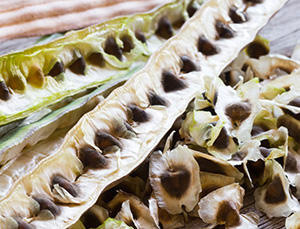 When growing moringa you basically have two options: to grow from seed or to grow from a cutting.
When growing moringa you basically have two options: to grow from seed or to grow from a cutting.
When growing from seed you’ll want to pick a spot with some sandy and light soil. Dig a fairly big hole and add some manure. Next, place about five seeds in (not too deep) and cover them with dirt. In the end water them, but don’t overdo it as it may cause rotting.
If you choose to go with using a cutting of the plant it is a little easier. Get a cutting that is about six feet long. Then dig a hole in the ground. Place the cutting in the hole and put a mixture of sand, manure. When watering, try to get it only on the ground around it and not directly on the stem of the new plant.
As you can probably see by now Moringa is a very powerful plant. It has many uses and more are being discovered every year. But would Moringa make a good addition to your preps? What do you think?
Editor’s note: Our reader Edna, grows and sells moringa tree seedlings and is licensed to ship to the 48 contiguous states, except Arizona. If you would like to purchase plants contact her at ekelly@brier-ridge.com
You may also like:
 Black Seed – The Remedy For Everything But Death
Black Seed – The Remedy For Everything But Death
Arizona Farmer Accidently Discovers Trick to Turn Air into Water (Video)
Top 10 Foods to Grow for Survival

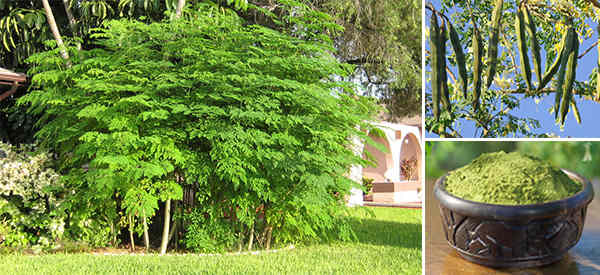













Need to get a couple
Your e-mail on 7/19/2018 regarding MORINGA tree is
most interesting. Could you show a simple map showing
where they can be successfully grown in the USA ?
Maybe just a list of those states. In Georgia ?
Many thanks—–Davis
Where can one purchase seeds or cuttings or seedlings?
What is the minimum temp the tree can survive?
Any other growing conditions one needs to know.
Hirt’s Gardens ships – found info at Walmart site. phone number posted 330-239-0506
where are the seeds to grow Moringa?
I had two moringa trees growing in the yard. Last winter we had a two day cold snap that killed both trees back to the roots. They are regrowing but I don’t think they are really a viable choice above zone 10. We are in zone 9A Eustis FL. I have also tried eating the pods and they require extra attention to preparation as they are very tough and stringy. Preparation instruction can be found online. They are also called drumstick trees.
Hello. I live near Ocala. Where can I find these? Thanks
Interesting. I’m in 7a (Pennsylvania) and there are several homes in the surrounding cities that have moringa in their yards. The one has been there for more than 30 years now.. through PA’s nasty winters.
Highly interesting article, and the benefits of the tree prompted research. The following website can answer a couple of questions from above: https://moringafarms.com/growing-moringa/
It has a hardiness zone map, instructions on how to grow, and seeds can be purchased from them. Other than following a link, I have no knowledge about Morning Farms, their ethics, or their interactions with customers.
I am just outside of the best area for planting the trees, because I get snow at times. So, I will probably be building a larger greenhouse to accommodate some trees.
I’d like to know where I can get some seeds. I live in North Florida.
I bought some from Amazon. I wasn’t successful in getting them to grow
From what I see of the map at moringafarms.com it grows in N central Florida and south Texas along the coast. It seemed like it will need to be potted and kept trimmed if grown anywhere else. The seed description does not match between the two, so I don’t know which is which.
Can you can or store the Moringa pods, leaves etc?
I ordered 100 seeds from good old Amazon for around $9.00 a few months ago with good results, around 70% propagation in peat pots under a grow light. I now have plants from 2” to 4’. They don’t like a lot of water but they love abuse. I have cut mine back halfway two or three times and harvested the leaves, dried, ground some and ate some. Also made tea w/ honey. It’s great. I also have a few I’m keeping in pots to bring inside in case of a nuclear event or chance of a freeze. This is the perfect prepper plant. Easy to grow in Central FL.
Thank you I live in N Central Fla. I didn’t know if you can can them in jars like you do peas or tomatoes etc.
How far south in Central FL are you? I am an hour and a half south of Orlando’s Airport
I am a Horticulturist, and it’s important to know that Moringa trees are tropical trees. They will only grow in Zones 9-11. Any zones lower than that and the tree will go dormant below 40 degrees. A way to grow a Moringa tree in Zones 7-10 is to cut the tree back to approx. 3 feet when the temperature drops, then insulate the tree including the root zone with a frame of chicken wire stuffed with lots of wood mulch, leaves or hay. In addition to insulating the tree, you can also plant it against a wall or house on the west or south side in full sun. You could also surround the Moringa tree with windbreak trees to help block windchill. Just make sure the surrounding trees don’t shade the Moringa tree.
“Moringa oleifera is a fast-growing, deciduous tree that can reach a height of 32–40 ft and trunk diameter of 1.5 ft.The bark has a whitish-grey color and is surrounded by thick cork. Young shoots have purplish or greenish-white, hairy bark. The tree has an open crown of drooping, fragile branches and the leaves build up a feathery foliage of tripinnate leaves.
“The moringa tree is grown mainly in semiarid, tropical, and subtropical areas, corresponding in the United States to USDA hardiness zones 9 and 10. It tolerates a wide range of soil conditions, but prefers a neutral to slightly acidic (pH 6.3 to 7.0), well-drained sandy or loamy soil. In waterlogged soil, the roots have a tendency to rot. Moringa is a sun and heat-loving plant, thus does not tolerate freezing or frost. Moringa is particularly suitable for dry regions, as it can be grown using rainwater without expensive irrigation techniques.”
This is a fairly large tree. If you have limited yard space, It might get to be too large for the area available. While it would be ideal and probably grow quite well in coastal SoCal my lot size wouldn’t allow something that big.
If you look at the picture, the tree pictured is growing on a lot that looks as if it were Oprah’s mansion in Montecito, not some suburban 7,000 square foot lot.
Interestingly, after the fires last December I noticed that a lot of tree trimmers were busily engaged in either severely cutting back or removing large trees from various homes. Hmmm.
I know of a moringa grown in a small lot. When it gets too big, the top is cut off at about 6 or 8 feet above the ground. Some of the cut trunk can be used as a cutting to start another tree/trees.
It grows back from the stump, and it sends up new shoots from the roots. Some of the cuttings that I have seen planted grew well, Some died. I don’t know why some prospered and some did not.
When the tree top is removed, it grows back from the stump and the roots. Some of the cuttings that I saw planted prospered. Some of them died.
A cousin in Maui keeps his cut back. they make a good mid-sized hedge plant and give plenty of leaves and mulch for their garden. I’ll be happy here in Zone 9A if it gets 20 feet tall before freezes knock it back to the roots. 🙂
May grow quite nicely in zone 8b. The die back after the first freeze. I mulch the lower trunk and roots. They always grow back in the spring. I top them at about 8’ and it makes them very bushy. Lots of leaves to dry and make tea out of.
I would like to know more about them and where to get them.
I purchased seeds from Amazon. You might also try ebay and etsy.
great ideal simplicity in its perfect definition thank you godspeed
I have to say this about moringa and other prepper plant choices. I have one acre and grow or at least try to grow as many tropicals as possible in zone 9a. The most productive, nourishing and fastest plant I have found to date is broccoli sprouts. You can have an edible crop within 5 days of setting up your seed sprouting tray. They require little water and no fertilizer or soil. One trays worth can easily sustain a person for a week Pineapples, papayas and bananas are also quick growers but do best with frequent watering and fertilizer. Thus requiring more work.
Good info but you don’t say where you can get either the seeds or cuttings? Have never seen at local nurseries so have no idea where to start looking. I live in TX — temps this week 107-109 so assume will grow well, but we do have some pretty nasty freezes some winters. Can/should you wrap or cover to protect?
You can order seeds online. I looked up the type of tree and it gave several websites that sold seeds.
You should protect them from too much summer sun. As I understand it, they don’t like a lot of sun when it’s over 95 degrees. Mine are doing OK, except the birds like to pull the seedlings out of the pots to eat the seed. I had to replant 2 this morning, but they’re tough. I got my seeds at JL Hudson. niio
I just went on Google ordered mine so far most of what I have planted have propagated I planted one in an outside flower pot, put onions around the pot. I forgot about the Moringa seed, said it came up in the onion patch ha ha
Here is a helpful website by an expert on Moringa. http://moringaforlife.com/ A lot of answers can be found here.
Freezes anywhere north of Brownsville, TX and South Florida, but cutting it back once or twice a year increases its productivity while keeping it compact, so if you can put it in a hot house in winter be a nice plant.
I have a dozen honey mesquite trees in my yard, the leaves aren’t as useful but they fruit heavily and the pods are better tasting and more digestible than drumstick tree, plus there are thousands of acres of abandoned cropland around here covered in mesquite. Imagine the nameless Indigenes living along the Rio Grande for thousands of years unaware they were survivalists sitting on the rocky outcrops above the river grinding mesquite beans with sticks until the basalt and granite is honeycombed with mortar holes 3 feet deep.
This is slightly off topic, but in response to IvyMike. I took this from the Texas A&M website concerning honey mesquite
“The seed pods are an important source of food for insects, livestock, deer, birds and small mammals. However, the seeds can be toxic in large quantities. Mesquite beans can be toxic if a primary food source for cattle and goats. Symptoms of disease include loss of appetite, rapid weight loss, bulging eyes, and death.”
“Large quantities” is undefined. Primary food source is a little more definitive. I am surprised that it can be fatal to goats. Up until I read this I was always under the impression that if it grew in the ground with certain very rare exceptions, goats could eat it. Looks like I get an F in goat husbandry.
It would be nice in an advisory post like this if “large quantities” was more precisely defined. I recently had a surgical procedure and one of the pre-op questions was. “Do you drink more than 3 drinks a day?”
I don’t know if they deliberately don’t want an accurate answer to avoid certain liability questions in the event of an untoward incident (that’s doctor speak that means they screwed up badly) because if drinks are undefined they can always supply what they had in mind at trial versus what the victim — err, patient had in mind. After all, a “drink” can range from a weak one ounce highball to an eight ounce water glass full of whiskey and anything in between.
So, we are left to wonder what a “large quantity” of mesquite beans is. Considering that for Southwest Indians, mesquite beans seem to have been a large (there again, that mysterious “large”) part of their diet, TA&M must have some significant quantity in mind. It would be nice if they had put it in terms of body weight such as, “If you consume more than 10% of your body weight of mesquite beans in a 24 hour period, you are liable to have mesquite poisoning.”
Or “If you consume more than a pound of mesquite beans a day for more than 30 days you will exhibit signs of mesquite bean poisoning.”
If I knew who to write to about their website, I would send them an e-mail asking them to amend their website to be more informative.
The idea of a moringa tree in a planter box is intriguing. I might try that avenue. I certainly don’t have room for a foot and a half diameter trunk and a 32 foot high tree in the little patch that over enthusiastically is described as a back yard. To those who suggested a planter box, thank you. That’s what is so valuable about this website is folks offering their ideas and their experience. And, unlike other websites there is a limited amount of unhelpful name calling.
Just google up mesquite bean recipes, stay away from Texas A&M, they are the pestilential poltroons who invented the mild jalapeno pepper, offense to God and Mankind.
I did some irrigation work today for a couple who emigrated here from India a couple years ago. They are engineers and live in an upscale neighborhood, but their backyard looks like a communal garden in some little Indian Pura, kind of chaotic, eclectic, almost accidental. The first thing I noticed was a couple of seedling drumstick trees growing in pots, they had several different cucumbers, tomatoes, peppers, oddly enough a five foot tall kale plant growing in a big tomato cage. Kale gets extremely bitter here in the summer, but this one had never bolted, mine are generally flowered and gone by that lovely spring Holy Day of Apr. 15. What really got my attention was that they were cultivating Giant Pigweed, the bane of the Southern cotton farmer. In fact one of the 1st GMOs was Glyphosphate resistant cotton so farmers could just spray Roundup on the cotton instead of having to cultivate it. It only took the pigweed two seasons to naturally evolve its own resistance to the herbicide.
So hats off to all the Preppers of India ready to live off drumstick beans, Amaranth, cucumbers, and okra! They’d make pretty good Cajuns, I’m thinking.
Look up Cathy Voss on Pastures. She and her husband ranch south of Tucson. An agronomist, she trained cattle to eat mesquite and other brush and saved them from the need to sell off the herd during the drought. Mesquite poisoning is the same as clover poisoning with the same results. I like mesquite and moringa, as well. One compliments the other.
I’m interested but the moringa would have to be greenhouse grown. Still it seems like s plant worth growing.
So far as I know, it does. It’s recommended if you live north of Zone 9, you take it inside for the winter. It would likely do a lot better in a greenhouse than a window in the house. I just replanted a couple of seedlings the birds ripped up. might be they didn’t like the greens, too hot, but did like the green amaranth that came up with the red. I’m about ready to look up that recipe, 4 and 20 birds baked in a pie. niio
Totally illogical choice taking into account it’s for zones 9 and 10. In other words, 90% of the US is colder, if we are at the start of a mini-ice age, that would make it able to survive in 1% of the US.
My admittedly limited experience with moringa tells me it is not worth the trouble for the small amount of seed pods it produces. Squash and carrots are faster and produce more. Its nice to think there is some “tropical mystery tree” that will fulfill all of your prepper needs but it is hard to beat the old reliables.
How coincidental, I was talking about moringa with my neighbor just yesterday. I bought a very young tree from my local herbalist this Spring. This baby grew from a four-inch plant to two feet in about two months or so. I have it on a big pot outdoors at the moment. My neighbor from Philippines recognized it but she calls it malungay. She asked me what I was going to use it for and I said for tea from the leaves. Then she told me in Philippines they use all parts of it. She told me they even cook the seedpods, etc. At first I thought she must be confusing the plant with something else, but after reading this post now I understand it’s the same tree. Wasn’t aware of this info. Thanks! I might try to propagate from cuttings this year and see how it goes.
simple question – what does it (any and all parts) taste like? Or…. does it taste good or bad? Here in Florida, there’s an invasive plant that is ‘healthy’ – called Caesar weed – but tastes like dreck. Inquiring mind and all that wants to know.
My one experience of trying to eat it was kind of bland and very tough.
The raw leaves taste green and a little peppery (hot). Not bad in my opinion. But not something that you would want to eat a lot raw. Cooked, I never noticed any heat.
From what I’ve read, you don’t want to eat more than a seed or two for kidney’s sake. Same with root, it is called horse radish tree because of that wasabi bite. I nibbled a seed and drank some water, the water tasted like it was sweetened with sweetener, the sweet taste lasted till I couldn’t drink another sip. Be careful and don’t over do, a lot of things/plants can mess up your kidneys.
This has given me some “food for thought”! (Pun intended!) Perhaps some readers might be interested in a book I got a while ago called “Grow A Little Fruit Tree: Simple Pruning Techniques for Small Space, Easy-Harvest Fruit Trees” by Ann Ralph.She focuses on the traditional fruit trees: Apples, Apricots, Figs, Peaches, Cherries, Pears, Plums, and Persimmons, but it might be worth a look and maybe even some experimenting. To see if this technique would work with other fruit bearing trees. Especially if they must be grown in a green house. She states herself that the book isn’t a “technical manual”, instead she views it as a handbook and encouraging companion. If you’re interested, check your library or maybe the used book store. Hope this offers some food for thought!!
We have been growing moringa for about 15 years. My son has Crohn’s Disease and after 2 surgeries to remove damaged parts of his intestines, the doctors said there was nothing else they could do other than prescribe stronger pain meds. He started eating moringa leaves as a last resort, figuring they sure couldn’t make it any worse. In a matter of months, he was in remission and has remained Crohn’s free ever since. Now we grow about 20 trees, harvest the leaves, dry them and sell the powder at a local farmers market. We also sell moringa seedlings.
I credit moringa with improving my asthma, very slowly but surely.
We don’t cook the seed pods or eat them.. there is a very brief window of time where they are nice and tender and for us, at this time, it’s more bother than it’s worth. However, when we gather them, we cook exactly as we would fresh green beans from the garden. They are very good.
We swear by this tree both for nutrition and for health.
And as my son likes to say, when TSHTF, most people won’t see these trees as food so they will be safe!
If you can’t find seedlings locally, we are a licensed and inspected nursery in SW Florida and we can ship to any state except Alaska, Arizona and Hawaii.
I would like to try to grow as an indoor plant
Hi again, sorry having trouble with the computer. And, it doesn’t help to have your dog come along and nudge your arm causing things to either be erased or sent unfinished. Interested in purchasing the powder. Wanted to grow the tree, but here in PA it gets a bit cold. Could you please give me a price for the powder? Your address/phone number is not listed.
Thanks.
I forgot to mention…
If you live in a climate colder than Zone 9, grow moringa in a large container, the largest size you will be able to move indoors come cold weather.
Keep the tree pruned to a manageable size. You want to harvest the leaves so keep them where you can reach them. We cut ours back to about 3ft tall every spring for exactly this reason. And although this tree is drought-tolerant, it will drop its leaves if it is too dry. It will also drop leaves if too wet. And regardless, don;t expect heavy leaf production during the winter months. Even here in our zone 10 yard we get very few leaves during our “winter”… which is mostly bone dry.
I will happily answer questions about moringa but only from my own personal experience growing this tree. I am not a Master Gardener, botanist, or any other kind of expert… just an old lady who likes to grow things!
I live in zone 9a and have two moringas. Last winter they both froze back to the roots. Both have put out new growth with one already reaching ten feet and having seed pods. Based on my experience I don’t believe they can be anything but container grown above zone 10 or better.
How do I aobtain this plant/tree
I think it was “Paisley farms” on eBay. They are in Florida. The seeds I got were good. Over 90% of them sprouted. You need to do a little research on YouTube to learn how to sprout and plant. Good luck.
Moinga oleifera Lam (Moringaceae) іs a quite common food plant wіtһ medicinal
prpperty and geographically distributed іn tropical nations.
I’m afraid my problem is opposite of PA’s. Too hot in Arizona. One is planted under the shade of a large pine and seems to be doing well there. 4 more are still potted, waiting for the summer rains. A friend in south N. Jersey had hers in a ten gallon container in her greenhouse where it did well. niio
“Moringa is a tree that loves arid conditions,”… Oh, great! It won’t help me in the northern parts of Pa.
Gotta Tell you folks, I found Moringa about a year ago, I am very impressed with it. Very nutritious, tastes kinda like spinach, I have used it in many dishes,
It’s a food tree in the yard. I live in the tropics, so no worry about freezing.. don’t worry about the pods, the leaves are abundant and tasty, excess can be dried for a 2 year shelf life. I have recommended it to many friends in CA, Texas, AZ., Fl. I have no worries about food.
When I want to grow something that I don’t know if it will survive in my area. I take a fun drive through the oldest part of town with the most wonderful old homes and mansions. I look for the Moringa Tree there if I find one I park and take a walk. I talk to the residents and ask for some seeds, or if no one is about I pick up a few seed pods from the ground specially if they are littering the side walk and I have my answer. Plus I have my seeds and picked up some litter from the tree.
I love this artlcle. Thank you for all the help in preping
Excellent post. I especially liked the water purification part, something i never knew about before.
I purchased a small tree for over $100.00 from a S. Carolina nursery . The tree is pretty delicate. Wilted badly even in shipping . Everytime i moved the plant it seem to go into shock. even when it was in a large pot. It lasted 9 months and died . I took it inside during the cold months and put it out side during warmer months . I live near Seattle. Kool tree though …..I think it would like to live on Hawaii.
Ok, you got ripped off. If you disturb the root it will kill the tree. I grow them fro seed and sell them for 15 bucks and seeds for 2 bucks a bad of 12. They grow very easily from seed and reach 6-8 feet in a couple months. For your area it’s just better to grow them in early spring and let them die in the winter. Harvest and dry the leaves for a very nutritious tea all year around.
I live in central texas zone 8B. I have 20 trees in raised beds on my farm. I top them at around 8’ and harvest the leaves. I dry them and make them into tea. I add it to my soups and put it into my sweet tea, i bulk bag it and sell it at the farmers markets. It does die back in the winter. I cut it to about foot high and mulch around the base. Even with snow it grows back in the spring. I stared all of them from seed. Some to sell and some to expand the numbers. I love the smell of the tea. The tea smelsl like fresh cut grass.